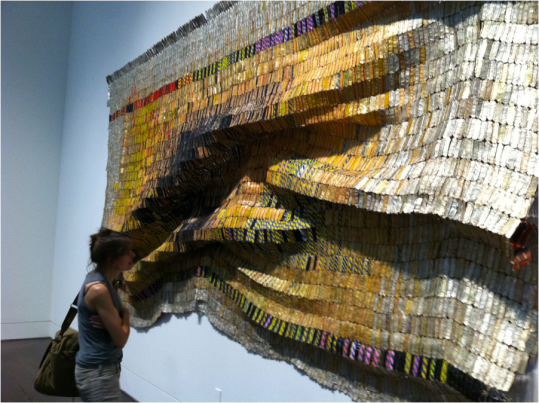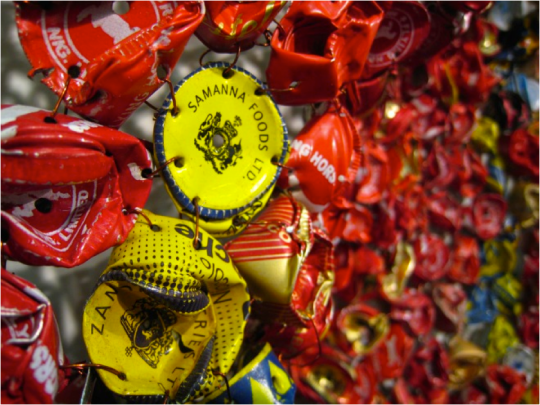by Christopher Hutchinson
Formal & Global
Mr. Anatsui’s wall hangings, majestic as they are, do not use scale as a cudgel. That’s true even of high-profile works like his mural at the High Line and of the wall-spanning, rotunda-filling examples in the Brooklyn show. Only after you have marveled at their intricacy and versatility does the vastness hit you. It helps to know (as many people do, now that Mr. Anatsui is a global star) that these peaked, shimmering fields are made from folded, twisted and linked liquor-bottle caps, at studios in Ghana and Nigeria, and that they have as much to do with post-colonial poverty and strife as they do with opulence. –KAREN ROSENBERG http://www.nytimes.com/2013/03/01/arts/design/gravity-and-grace-by-el-anatsui-at-brooklyn-museum.html
El Anatsui has made his way to the top of the art scene using his famous tapestry technique using beer bottle caps. His work has been well respected for years now and deserves a serious conversation as to how his work really functions in this art world. Anatsui is often considered to be a Global artist and sometimes even a Post-Colonial artist. These two terms are often used synonomously, but that would be a mistake. To become a global artist means something very different than being a post-colonial artist. A global artist refers to “universal” appeal. That “universal” appeal is often decided and upheld by the Western rubric of formalism.
“Formalism is a particular mode of art criticism and theory according to which all visual art has an intrinsic value. This value is determined by the artist’s ability to achieve an aesthetic order and balance of certain elemental truths within a painting. These elemental truths are the painting’s use of color, line, composition and texture. No matter how much artistic style and taste may change over time, formalism holds that these truths are constant.” http://www.theartstory.org/section_theory_formalism.htm
This formalism is inseperable from Western academia, which is then applied to Global art and artists. From this point Anatsui is a Global artist by how his works function in the current art world. He does discuss his heritage and significance of African/Ghanian aesthetic, but the process of formalism, and globalization nullify the African/Ghanian voice. His work is firstly discussed through the practice and assembly of his wall sculpture. The dialogue is reduced to formal elements, mainly, color, and form. While formalism is a good way evaluate art, but it also a tool to eradicate identity and ethnicity.
EcoArt & Upcycling
Anatsui’s work also has a dialogue that coincides with green art, ecoart, upcycling, saving the earth one bottle cap at a time. These are all good things for an eco-conscious collector, but what does this have to do with African tapestry? Are the beer bottle caps justified? Could this not have been achieved with African/Ghanian tapestry? Is the labor and process most important? Is this really more or less successful than Sam Gilliam’s work?
These questions beg for more specificity in the work of Anatsui. Is the bottle cap the large red shiny technique? Does this technique add or detract from the concept? Can we even get to the concept? Or are we just enamored by the sparkly, pieces in museum lights? Anatsui’s scale seems haphazard at times. His dimensions are often flat. These are major undergraduate concerns.
Craft & Primitive
“Prinitivism-Term used to describe the fascination of early modern European artists with what was then called primitive art – including tribal art from Africa, the South Pacific and Indonesia, as well as prehistoric and very early European art, and European folk art
Primitivism also means the search for a simpler more basic way of life away from Western urban sophistication and social restrictions. The classic example of this is artist Paul Gauguin’s move from Paris to Tahiti in the South Pacific in 1891. Primitivism was also important for expressionism, including Brücke.
As a result of these artists’ interest and appreciation, what was once called primitive art is now seen as having equal value to Western forms and the term primitive is avoided or used in quotation marks. –TATE http://www.tate.org.uk/learn/online-resources/glossary/p/primitivism
There is a strong element of the “Primitive” present in the dialogue around Anatsui’s work, even though the work itself has been formalized and globalized. The “Primitive” raises its head when his work is exhibited along side the “primitive: African sculpture” collection at the Metropolitan Museum of Art in 2006. Once again questions arise. What is the purpose to put Anatsui’s work side by side? What is being proven by doing this? Here we have an authentic African artist fullfilling the lineage of Gauguin as true “primitivist.” Anatsui himself discusses the use of the bottle caps as bridging the gap between Europe and Africa. The bottle caps being introduced by Europeans who brought beer. Here in lies the truth behind all globalism. If you want to be successful you must first “bridge the gap.” Second you must acknowledge the Western art history directly in your work. This by no means is Post-colonial.
 Christopher Hutchinson is an Assistant Professor of Art at Atlanta Metropolitan State College, Archetype Art Gallery Owner in Atlanta, Ga, and Smoke School of Art Founder. He received his Master of Fine Arts Degree in Painting from Savannah College of art & Design, Atlanta and his Bachelor of Arts Degree from the University of Alabama in Huntsville, Alabama. He lived in Alabama for 10 years before moving to Atlanta in 2008.
Christopher Hutchinson is an Assistant Professor of Art at Atlanta Metropolitan State College, Archetype Art Gallery Owner in Atlanta, Ga, and Smoke School of Art Founder. He received his Master of Fine Arts Degree in Painting from Savannah College of art & Design, Atlanta and his Bachelor of Arts Degree from the University of Alabama in Huntsville, Alabama. He lived in Alabama for 10 years before moving to Atlanta in 2008.
Learn more about Christopher and his work at Black Flight 144.










Thank you for this interesting analysis of El Anatsui’s work. I would be very interested to hear more about why you have specifically chosen to describe/characterise the artist as (quote) “…an authentic African artist” (in the section above on “Craft & Primitive”), as I find labels such as “authentic” and “inauthentic” somewhat problematic when applied in this context…especially when one considers the dynamic and ongoing inter-continental processes of movement, migration, exchange and flow that have always occurred (before, during and after the colonial period in continental Africa)…
LikeLike
Sure… In the context of primitivism, using Africa/primitive from Western perspective. Anatsui fulfills the Gauguin Tahitian rubic by literally being indigenous using the vocabulary of the West. My query is interested in how we receive this work. If it is through sympathy, then that is problematic. You make a good point about the changes Africa has gone through. Thanks for reading.
LikeLiked by 2 people